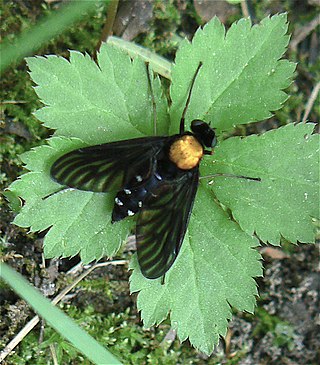
The Brachyceran infraorder Xylophagomorpha is a small group that consists solely of the family Xylophagidae, which presently contains subfamilies that were sometimes considered to be two small related families. Other obsolete names for members of this family include Exeretonevridae and Heterostomidae.

Chrysopilus is common, worldwide genus of predatory snipe flies. There are approximately 300 species in the genus, including fossil members that are sometimes found in amber.

The Apioceridae, or flower-loving flies, are a small family of flies, all in the single genus Apiocera. They occur mostly in dry, sandy habitats in the deserts of North America, South America, and Australia. Other genera formerly placed in Apioceridae are now in Mydidae.

The Pyrgotidae are an unusual family of flies (Diptera), one of only two families of Cyclorrhapha that lack ocelli. Most species are "picture-winged", as is typical among the Tephritoidea, but unlike other tephritoids, they are endoparasitoids; the females pursue scarab beetles in flight, laying an egg on the beetle's back under the elytra where the beetle cannot reach it. The egg hatches and the fly larva enters the body cavity of the beetle, feeding and eventually killing the host before pupating. In the United States, some species of Pyrgota and Sphecomyiella can be quite common in areas where their host beetles are abundant. Like their host beetles, these flies are primarily nocturnal, and are often attracted to artificial lights.

Heterometopia is a genus of flies in the family Tachinidae.
Chetogaster is a genus of flies in the family Tachinidae.
Prodiaphania is a genus of flies in the family Tachinidae.
Rutilotrixa is a genus of parasitic flies in the family Tachinidae.
Spaniopsis is a genus of snipe flies of the family Rhagionidae. They are very stout bodied flies from 3 to 6 mm, with generally grey or dark grey thorax, and are only known from Australia.
Atherimorpha is a genus of snipe fly of the family Rhagionidae.

Laphria is a genus described by Johann Wilhelm Meigen in 1803, belonging to the family Asilidae, subfamily Laphriinae. Members of this genus are known as bee-like robber flies. This genus has a Holarctic distribution, occurring in Europe, Asia, and North America. They prey on a variety of insects, including other robber flies, bees, wasps and beetles. Like other asilids, they use their proboscis to penetrate the body of their prey and inject enzymes which dissolve the tissues.

Sergey Jacques Paramonov was a Soviet and Australian entomologist, specializing on flies (Diptera), of which described about 700 species and subspecies. Paramonov published over 185 scientific articles, some of which were published posthumously.

Amphibolia is a genus of bristle flies in the family Tachinidae.
Chrysopasta is a genus of flies in the family Tachinidae.
Dasyomma is a genus of flies in the family Athericidae.
Antissella is a genus of flies in the family Stratiomyidae.
Diochlistus is a genus of flies in the family Mydidae.

Prosoeca is a genus of tangle-veined flies in the family Nemestrinidae. It was described in 1867 by Ignaz Rudolph Schiner. It was assigned to the family Nemestrinidae by Frank M. Carpenter in 1992; and to the subfamily Nemestrininae by Mike Mostovski and Xavier Martínez-Delclòs in 2000.









